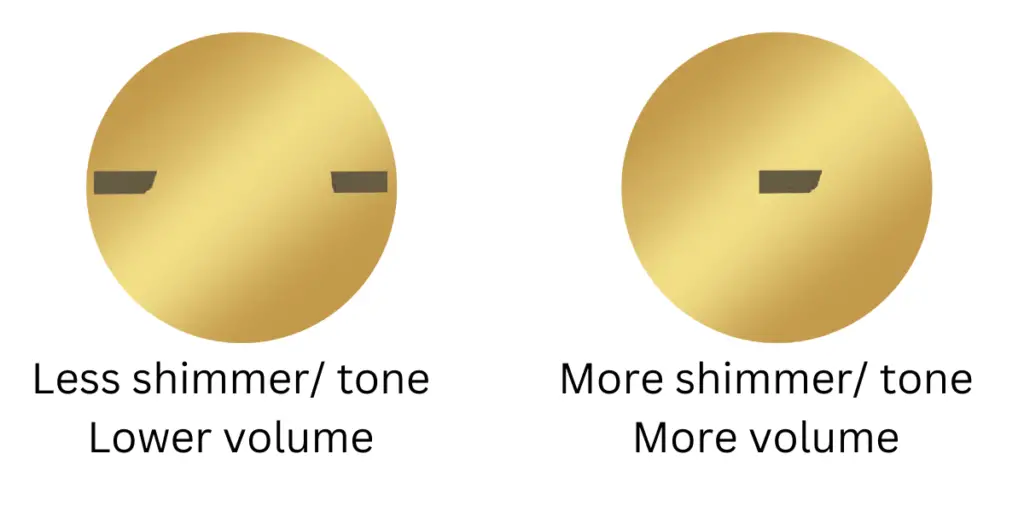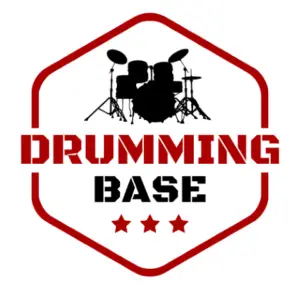The main reason why drummers want to dampen their cymbals is to reduce the volume, either for practicing or in smaller venues. Some drummers also like to dampen their cymbals to reduce the amount of ring and sustain. But what is the best way to dampen cymbals?
Best Ways to Dampen Cymbals
- Apply tape to the underside of the cymbal
- Put moongels on the cymbal
- Use cymbal tuners
- Tighten the screw on top of the cymbal
- Place a t-shirt or cloth over the cymbal
#1 Tape
One of the most popular and cheapest ways to dampen a cymbal is to apply tape to the underside of it. This will help reduce the volume and shimmer/ sustain.
There are two variables which affect how the cymbal will sound when taped:
- How much tape is used
- Where the tape is positioned
The more tape you apply to the cymbal, the more it will be dampened. This is useful if you want to dramatically reduce the volume and sustain, however it can cause the cymbal to sound a bit dead so you’ll need to find a balance.
One 2″ strip of tape might be enough to achieve the desired affect. But if you need to dampen them a lot, you may need a few 4″ strips of tape. You’ll need to play about and see what works for your situation.
The positioning of the tape also has a big impact on the sound of the cymbal. The closer the tape is applied to the edge of the cymbal, the greater the dampening effect will be.
Some drummers will tape the entire edge of the cymbal, and others will place large strips close to the edge to really reduce the volume, however it does kill most of the shimmer and sustain so won’t really sound great.
Applying the tape to the underside of the bell will have the least dampening effect and will just reduce the bell ring, which might not be enough for certain situations.

Also, if you apply the tape in a horizontal direction (across the middle) then it won’t have as much of an effect compared to if you apply it in a vertical direction (from the bell to the edge).
Top Tip: use gaffers tape instead of duct tape. It’s far less likely to leave any residue behind and can be removed much more easily. Here’s a link to some cheap gaffers tape on Amazon.
Advantages of Using Tape:
- Inexpensive
- Allows you to achieve different effects
Disadvantages of Using Tape:
- Can leave residue
#2 Moongel
Moongels are sticky and small little dampeners that are typically applied to drums but can also be used to dampen cymbals in a similar way to taping them. They are self-adhesive and can be cut up into even smaller sections if you only want to dampen the cymbals slightly.
Moongels are typically placed on the top side of the cymbal. Like with tape, the more you use and the closer to the edge you place the moongels, the greater the dampening effect will be but also the more lifeless it’ll sound.
Since moongels are heavier than tape, they tend to have a greater dampening effect but will also reduce the tone a lot more, so you may need to place them closer to the centre.
Here’s a link to a pack of moongels on Amazon.
Image links to Amazon
Advantages of Using Moongels:
- Allows you to achieve different effects
- Easy to apply/ remove
Disadvantages of Using Moongels:
- Can kill the tone too much
- Some drummers don’t like the look
#3 Cymbal Tuners
Cymbal tuners are essentially magnets which can be placed on top of the cymbal to change the sound by reducing some of the frequencies.
There are two main varieties of tuners: heavy and light. Heavy tuners of course will dampen the cymbal more, especially if placed closer to the edge. This can cause the cymbal to sound very lifeless though, much more than using tape or moongels.
They’re a great option for practicing as they will really reduce the volume if placed correctly, however for on stage and recording, they can choke the cymbal a bit too much for my preference.
Here’s a link to a pack of Meinl Cymbal Tuners on Amazon.
Image links to Amazon
Advantages of Using Tuners:
- No risk of residue
- Greatly reduces volume/ sustain
Disadvantages of Using Tuners:
- Dampening effect can be too heavy
- More expensive
Here’s a great video on YouTube which compares the dampening effects of tape, moongels and cymbal tuners.
#4 Tighten the Screw on Top of the Cymbal
This is a neat little trick if you only want to dampen the cymbals slightly, or it can be combined with any of the previous three dampening methods on this list.
If you tighten the screw attached to the stand on the top of the cymbal, it will prevent the cymbal from vibrating as much when it is hit. Since it restricts the cymbal from the centre, it doesn’t kill the tone too much. The drawback is that the effect is quite minimal.
It’s well worth trying though as it’s a free and quick technique.
Advantages of Tightening the Cymbal:
- Quick, easy and free
- Doesn’t affect the tone much
Disadvantages of Tightening the Cymbal:
- Very minimal dampening effect
#5 Place a T-Shirt or Cloth
Placing a t-shirt or thin cloth over the top of the cymbal is one of the oldest tricks to reduce the volume. It’s fine if you’re practicing at home and just need to stay quiet, but it does have several big disadvantages.
- It completely kills the tone
- It changes the feel of the cymbal
- The cloth/ t-shirt can slip off which is annoying
Consider Low Volume Cymbals
If you really need to quieten your cymbals and have found that the methods above either don’t sound great to your ears, or don’t dampen the cymbal enough, then consider purchasing some low volume cymbals. This is the best option if you want to preserve the sound quality of the cymbal.
Low volume cymbals use special metal alloys, and some have holes in them to reduce the mass and consequently, reduce the volume.
If you don’t want to go with specialist low-volume cymbals, at least try and choose a cymbal which is a bit thinner and has a smaller diameter.
Here are some more articles you might find useful:



